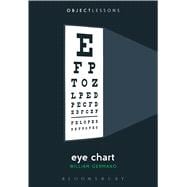Object Lessons is a series of short, beautifully designed books about the hidden lives of ordinary things.
What's an eye chart and how does it work? Desert nomads tested their vision by distinguishing a pair of stars, but we've created more anxiety-provoking ways to test the strength of our eyes. Encompassing a Spanish cleric's Renaissance guide to testing vision, a Dutch ophthalmologist's innovation in optical tech, and the witty subversion of the eye chart in advertising and popular culture, Eye Chart is an essay on the sharp, the fuzzy, and the invisible. It's about that familiar thing we read partially, and with difficulty. Reading the eye chart is an exercise in failure, since it only gets interesting when you can't read any further. To read the eye chart is the opposite of interpretative reading. You're supposed to read it up (the way we might use something up or eat it up). But you can't. It's like the shortest longest book in the world. Eye Chart is about that lesson in failure and unreadability that finally lets us see things.
Object Lessons is published in partnership with an essay series in The Atlantic.









